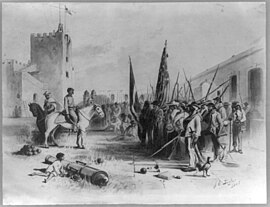 Santo Domingo City Watercolor by James E. Taylor 1871 | |
| Date | 1869 – 1871 |
|---|---|
| Location | Washington, D.C. |
| Participants | United States, Dominican Republic |
| Outcome | Treaty defeated in the U.S. Senate - June 30, 1870 |
The proposed annexation of Santo Domingo was an attempted treaty during the later Reconstruction era, initiated by United States President Ulysses S. Grant in 1869, to annex Santo Domingo (as the Dominican Republic was commonly known) as a United States territory, with the promise of eventual statehood. President Grant feared some European power would take the island country in violation of the Monroe Doctrine. He privately thought annexation would be a safety valve for African Americans who were suffering persecution in the U.S., but he did not include this in his official messages. Grant speculated that the acquisition of Santo Domingo would help bring about the end of slavery in Cuba and elsewhere.
In 1869, Grant commissioned his private secretary Orville E. Babcock and Rufus Ingalls to negotiate the treaty of annexation with Dominican president Buenaventura Báez. The annexation process drew controversy: opponents Senator Charles Sumner and Senator Carl Schurz denounced the treaty vehemently, alleging it was made only to enrich private American and island interests and to politically protect Báez. Grant had authorized the U.S. Navy to protect the Dominican Republic from invasion by neighboring Haiti while the treaty annexation process took place in the U.S. Senate. A plebiscite ordered by Báez, who believed the Dominican Republic had better odds of survival as a U.S. protectorate and could sell a much wider range of goods to the U.S. than could be sold in European markets, registered an improbably low 11 votes against annexation, compared to over ten thousand for annexation. The country's unstable history was one of invasion, colonization, and civil strife.
A treaty was drafted by Secretary of State Hamilton Fish that included the annexation of the country itself and the purchase of Samaná Bay for two million American dollars. Also included and supported by Grant was the provision that the Dominican Republic could apply for statehood. When debated in the Senate, Sumner staunchly opposed the treaty, believing the annexation process was corrupt and that the Dominican Republic was politically unstable, having a history of revolution. Sumner believed that Báez was a corrupt despot and that the use of the U.S. Navy by Grant during the treaty negotiation to protect Santo Domingo was illegal. Sumner said that the annexationists wanted the whole island and would also absorb the independent black nation of Haiti. Schurz opposed acquisition because he did not favor mixed-race people becoming U.S. citizens.[1] The treaty ultimately failed to reach the two-thirds vote needed under the Treaty Clause (the vote was a tie). In order to vindicate the failed treaty annexation, Grant sent a committee, authorized by Congress and including African American Frederick Douglass, that investigated and produced a report favorable to annexation of the Dominican Republic into the United States.
The annexation treaty failed because there was little support for it outside Grant's circle. The defeat of the treaty in the Senate directly contributed to the division of the Republican party into two opposing factions during the presidential election of 1872: the Radical Republicans (composed of Grant and his loyalists) and the Liberal Republicans (composed of Schurz, Sumner, Horace Greeley as presidential candidate, and other opponents of Grant).
- ^ Mejias-Lopez, Alejandro (2010-01-09). The Inverted Conquest: The Myth of Modernity and the Transatlantic Onset of Modernism. Vanderbilt University Press. p. 132. ISBN 978-0826516770.
